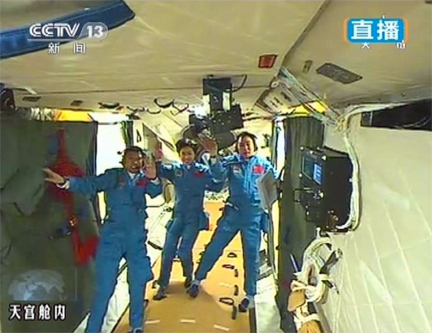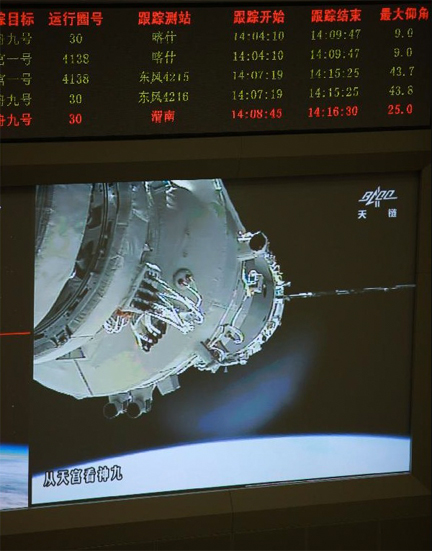Shenzhou 9 docks with Tiangong lab module
06/18/2012 08:42 AM Filed in: Space News | China
By WILLIAM HARWOOD
CBS News
The Shenzhou 9 spacecraft executed a smooth automated docking with the Tiangong 1 research module early Monday, completing China's first manned orbital linkup in a milestone for the nation's steadily progressing space program.
Following launch Saturday from the Jiuquan Satellite Launch Center in north central China, commander Jing Heipeng, China's first space veteran, and his two rookie crewmates, Liu Wang and Liu Yang -- China's first female astronaut -- began the terminal phase of the two-day rendezvous around noon Monday Beijing time (12 a.m. EDT; GMT+8) at a distance of about 32 miles, according to the Xinhua news agency.
From there, Jing monitored an automated approach to docking at 2:07 p.m. and in less than 10 minutes, the two spacecraft were firmly locked together. Television views downlinked at the Beijing Aerospace Control Center gave flight controllers clear views of the spacecraft during final approach. Later, after hatches were opened, all three Shenzhou 9 crew members could be seen floating into Tiangong 1's pressurized experiment module.
This is China's fourth manned spaceflight, the second for Jing, and the country's first crewed docking. An unmanned Shenzhou spacecraft carried out an automated docking last year, shortly after Tiangong 1 was launched.
The solar-powered Tiangong 1 measures 34 feet long, 11 feet wide and weighs about 8.5 tons. Along with the experiment module where visiting crews can live and work, the spacecraft features a "resource module" that houses electrical power, propulsion and life support systems.
Tiangong 1 is a prototype of the much larger laboratory components China hopes to launch and assemble in orbit later in the decade to build a Mir-class 60- to 80-ton space station by the end of the decade. While Chinese officials have mentioned the possibility of eventual flights to the moon, the space station project is the near-term focus of China's manned space program.
With the launch of Shenzhou 9, nine space fliers are currently in orbit -- the three Chinese "taikonauts" aboard the Shenzhou 9/Tiangong 1 complex and six astronauts and cosmonauts aboard the International Space Station -- two from the United States, one from the European Space Agency and three from Russia.
The International Space Station, jointly operated by the United States, Russia, Europe, Canada and Japan, weighs more than 450 tons and has a multi-module pressurized volume comparable to a 747 jumbo jet. It has been staffed with rotating crews of up to six astronauts and cosmonauts for the past 12 years.
Jing and his crewmates are expected to undock from Tiangong 1 later in the mission and then re-dock flying a manual approach. The mission is expected to last about 13 days. Chinese space officials have said a second manned flight to Tiangong 1 may be launched next year.
CBS News
 |
| Shenzhou 9 commander Jing Haipeng, Liu Wang and Liu Yang float inside the Tiangong 1 module after docking Monday. (Credit: Xinhua) |
 |
| Television views downlinked to the Beijing Aerospace Control Center gave Chinese flight controllers a clear view of the Shenzhou 9 spacecraft's docking with the Tiangong 1 lab module. (Credit: Xinhua) |
From there, Jing monitored an automated approach to docking at 2:07 p.m. and in less than 10 minutes, the two spacecraft were firmly locked together. Television views downlinked at the Beijing Aerospace Control Center gave flight controllers clear views of the spacecraft during final approach. Later, after hatches were opened, all three Shenzhou 9 crew members could be seen floating into Tiangong 1's pressurized experiment module.
This is China's fourth manned spaceflight, the second for Jing, and the country's first crewed docking. An unmanned Shenzhou spacecraft carried out an automated docking last year, shortly after Tiangong 1 was launched.
The solar-powered Tiangong 1 measures 34 feet long, 11 feet wide and weighs about 8.5 tons. Along with the experiment module where visiting crews can live and work, the spacecraft features a "resource module" that houses electrical power, propulsion and life support systems.
Tiangong 1 is a prototype of the much larger laboratory components China hopes to launch and assemble in orbit later in the decade to build a Mir-class 60- to 80-ton space station by the end of the decade. While Chinese officials have mentioned the possibility of eventual flights to the moon, the space station project is the near-term focus of China's manned space program.
With the launch of Shenzhou 9, nine space fliers are currently in orbit -- the three Chinese "taikonauts" aboard the Shenzhou 9/Tiangong 1 complex and six astronauts and cosmonauts aboard the International Space Station -- two from the United States, one from the European Space Agency and three from Russia.
The International Space Station, jointly operated by the United States, Russia, Europe, Canada and Japan, weighs more than 450 tons and has a multi-module pressurized volume comparable to a 747 jumbo jet. It has been staffed with rotating crews of up to six astronauts and cosmonauts for the past 12 years.
Jing and his crewmates are expected to undock from Tiangong 1 later in the mission and then re-dock flying a manual approach. The mission is expected to last about 13 days. Chinese space officials have said a second manned flight to Tiangong 1 may be launched next year.